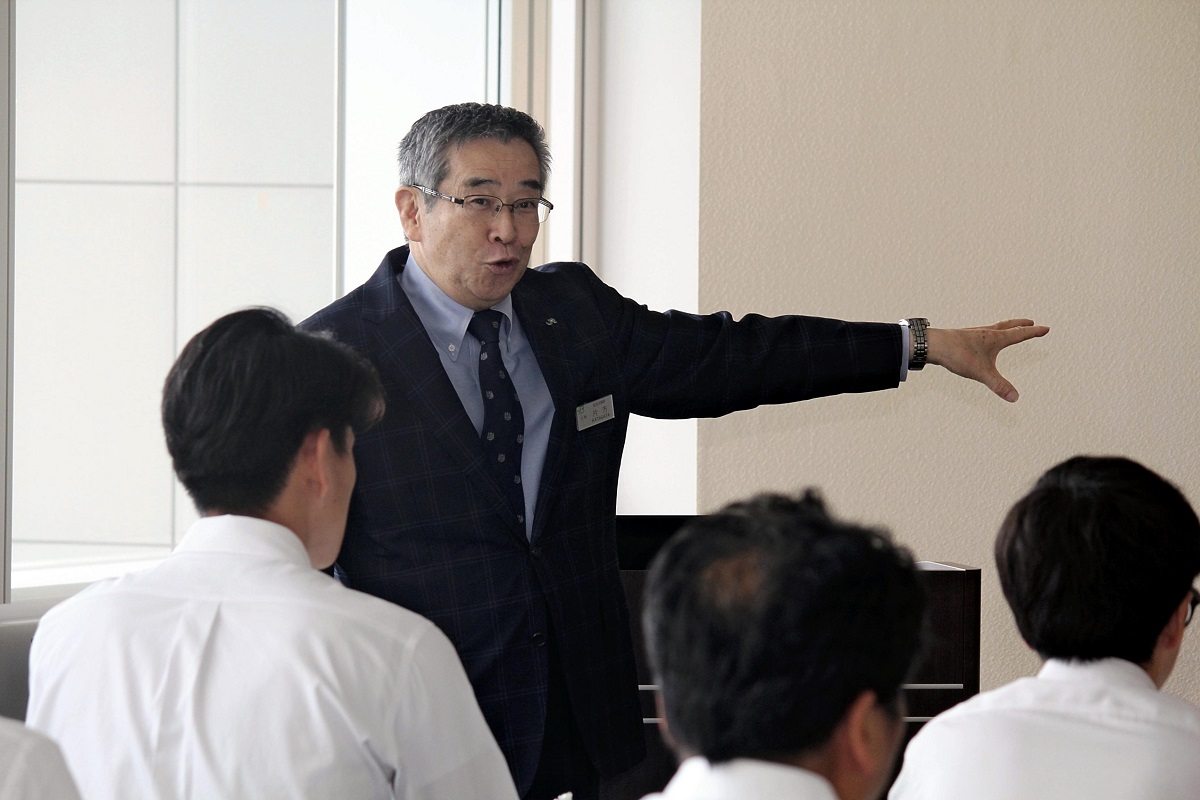JR East Employee in His 70s Earns Doctorate on Safe Train Operations; Believes Accidents Caused by Human Error Can Be Reduced

Yoshinobu Katagata explains the importance of safety at a JR East employee training session on July 3 in Shibuya Ward, Tokyo.
13:17 JST, September 23, 2024
Yoshinobu Katagata, a senior engineer at East Japan Railway Co. (JR East), has earned a doctorate from a graduate school at the University of Tsukuba with a thesis on the history of railroad accident prevention technologies.
The thesis was the fruit of his hard work after turning 70.
Katagata, 73, has been involved in railroad safety measures since the days of the Japanese National Railways, which was later privatized and broken up into different companies, including JR East. He currently works in the company’s Safety Management Department.
“There is no goal in taking measures to achieve ultimate safety,” Katagata said.
Katagata studied fluid engineering at an Ibaraki University graduate school and then joined the Japanese National Railways in 1976, where he designed signaling systems and rail yard facilities for the Tohoku Shinkansen Line, which was under construction for its opening in 1982. Later, he was involved in the development of operational safety equipment such as the automatic train stop (ATS) system.
Katagata still remembers an accident that occurred on Dec. 5, 1988, after the Japanese National Railways was privatized.
A train stopping at Higashi-Nakano Station on the Chuo Line was rear-ended by the train behind it, killing the driver of the train behind and a passenger, and injuring 116 people. It was the first fatal accident for JR East.
The driver of the train behind had noticed an alarm from the ATS system but did not apply the brakes appropriately, resulting in the train passing a stop signal.
In 1987, the ATS-P system, which is more sophisticated than the ATS system and brakes automatically, was already in use on some train lines. However, the Chuo Line was not equipped with the ATS-P system at the time of the accident.
Katagata strongly felt that accidents caused by human error can be reduced but cannot be completely eliminated.
Immediately after the accident, JR East accelerated the installation of the ATS-P system and also drew up the “priority plan for improving safety equipment.”
Katagata has been involved in the plan since its initial stages. The plan was renamed the Group Safety Plan and underwent its seventh review this fiscal year. He participated in its formulation again.
Sharing with younger generation
In 2021, after reaching the retirement age and becoming a contract employee of JR East, he enrolled in the doctoral program of the University of Tsukuba’s Graduate School of Policy and Planning Sciences.
Prior to the move, when he was responsible for training younger employees in the field of safety, he felt that academically systematizing the practice of safety measures would make it easier to understand the practice.
The topic of his thesis is the history of technologies for preventing trains from passing stop signals. To write the thesis, Katagata analyzed JR East’s record of accidents and near-accident incidents since fiscal 1958 and examined their situations and numbers. He also studied literature from overseas railroad companies.
The thesis has reaffirmed the fact that improving train driving rules and creating appropriate systems to eliminate human error, a factor in causing accidents, can also reduce the burden on train drivers.
Katagata completed his graduate studies in the spring and was awarded a doctoral degree. He will share his 90-page thesis with the younger generation now responsible for safe train operations.
“Although the equipment continues to develop, I hope they will not rely on it too much and always place top priority on building safety mechanisms,” Katagata said.
"Business" POPULAR ARTICLE
-

Japan Govt Adopts Measures to Curb Mega Solar Power Plant Projects Amid Environmental Concerns
-

Core Inflation in Tokyo Slows in December but Stays above BOJ Target
-

Major Japan Firms’ Average Winter Bonus Tops ¥1 Mil.
-

Bank of Japan Considered U.S. Tariffs, Coming Shunto Wage Hike Talks in Its Decision to Raise Interest Rates
-

Institute: 2026 Condo Supply in Tokyo Metropolitan Area Forecast to Increase by 2.2%
JN ACCESS RANKING
-

Japan Govt Adopts Measures to Curb Mega Solar Power Plant Projects Amid Environmental Concerns
-

Core Inflation in Tokyo Slows in December but Stays above BOJ Target
-

Major Japan Firms’ Average Winter Bonus Tops ¥1 Mil.
-

Bank of Japan Considered U.S. Tariffs, Coming Shunto Wage Hike Talks in Its Decision to Raise Interest Rates
-

Tokyo Zoo Wolf Believed to Have Used Vegetation Growing on Wall to Climb, Escape; Animal Living Happily after Recapture



























